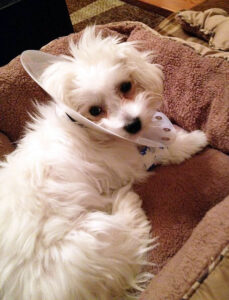On a cold autumn evening in 1999, my cat Midnight was born homeless under somebody’s front porch. As black-cat superstition foretells, the odds were stacked against her from day one—Midnight was also born the tiniest in her family. Fortunately for Midnight, her early struggles gave her a spicy attitude and a scrappy will to survive. Rather than sleeping under a porch, Midnight now claims all of the human beds in my house as her own.
When it became time for her spay surgery shortly after her adoption, my worrisome five-year-old self imagined dozens of worst-case scenarios. I harassed my parents with questions such as: Is surgery safe for her small delicate body? Would her tiny head be able to hold up that huge plastic cone? What if that cone makes her lose her mind? Will she ever recover? Is surgery really worth the trouble she might go through?
As a result of Midnight’s successful spay, I now understand that sterilization surgeries are routine and are safer than the risks of keeping her intact. Of course each time an animal goes under anesthesia some risk is involved, but LazyPaw Animal Hospitals mitigates risk by performing a preoperative physical exam and blood work to determine if the patient is healthy enough for surgery. If patients are not good surgical candidates, surgery is cancelled and care options are discussed with the family instead of proceeding with the procedure in a high anesthesia risk patient. During the procedure, there are always at minimum two trained veterinary technicians available to assist if a complication occurs, and an intravenous catheter placement is done to provide fluids, maintain blood pressure, and for use in case additional therapy is required. These precautions help decrease risk and make the procedure as safe as possible.
All patients are monitored during anesthetic recovery and complications are reduced by following post-op instructions which are reviewed during the discharge. Because Midnight’s post-op medication was given as directed and because she was restricted from running and playing while her incision was healing, she thankfully experienced no complications during her recovery. She also wore an e-collar (commonly known as the plastic “cone of shame”) which prevented her from licking her incision and was a crucial part of her smooth recovery.
Midnight’s spay benefited her in other ways in addition to preventing her from becoming pregnant. Spaying her before her heat cycle decreased her risk of bleeding during surgery and helped shorten her recovery time. It also eliminated her risk of developing ovarian and uterine cancer, and significantly reduced her risk of developing a mammary tumor.
Neutering also produces more benefits in addition to preventing a male from impregnating a female. It reduces his unwanted testosterone driven behaviors such as roaming away in search of a mate, marking, and aggression. It also eliminates his risk of developing testicular cancer and reduces his chance of developing prostate disease. It is commonly believed that neutering a young animal will stunt his growth, but his growth is actually determined by his genetics and will not be affected by his neuter surgery. Neutering an adult male can lengthen his recovery time and may not reduce long ingrained marking behaviors.
Spaying Midnight helped many more animals than her alone because when more pets are sterilized, fewer unwanted animals are born. Every year in the United States, millions of unwanted dogs and cats enter animal shelters and face possible euthanasia if they are not adopted. Sterilization is the most effective way to help reduce the number of animals who struggle in shelters. Midnight and the rest of her siblings are now part of loving human families committed to their life-long care. But many other kittens like Midnight are never adopted. Now that Midnight is spayed, she will never give birth to more kittens who have to struggle like she and her siblings did.
Sterilization surgery provides patients numerous health benefits. It is ideal to spay females before their first “heat” (estrus) cycle in order to reduce the chance of pregnancy, maximize health benefits, and decrease risks during surgery. Neutering a male early reduces unwanted testosterone driven behaviors and reduces surgical recovery time. After surgery, give medication as directed, be sure your pet wears an e-collar during recovery to prevent incision disruption, and restrict them from physical activity to ensure uncomplicated, fast recoveries.

